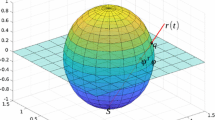Abstract
We consider the method that computes the shape orientation as the direction α that maximises the integral of the length of projections, taken to the power of 2N, of all the straight line segments whose end points belong to the shape, to a line that has the slope α. We show that for N=1 such a definition of shape orientation is consistent with the shape orientation defined by the axis of the least second moment of inertia. For N>1 this is not the case, and consequently our new method can produce different results. As an additional benefit our approach leads to a new method for computation of the orientation of compound objects.
Similar content being viewed by others
References
Boutsen, L., & Marendaz, C. (2001). Detection of shape orientation depends on salient axes of symmetry and elongation: Evidence from visual search. Perception & Psychophysics, 63(3), 404–422.
Chandra, D. V. S. (1998). Target orientation estimation using Fourier energy spectrum. IEEE Transactions Aerospace and Electronic Systems, 34(3), 1009–1012.
Cortadellas, J., Amat, J., & De la Torre, F. (2004). Robust normalization of silhouettes for recognition applications. Pattern Recognition Letters, 25(5), 591–601.
Fahlbusch, S., et al. (2005). Nanomanipulation in a scanning electron microscope. Journal of Materials Processing Technology, 167(2–3), 371–382.
Ha, V. H. S., & Moura, J. M. F. (2005). Affine-permutation invariance of 2-d shapes. IEEE Transactions on Image Processing, 14(11), 1687–1700.
Jafari-Khouzani, K., & Soltanian-Zadeh, H. (2005). Radon transform orientation estimation for rotation invariant texture analysis. IEEE Transactions on Pattern Analysis and Machine Intelligence, 27(6), 1004–1008.
Jain, R., Kasturi, R., & Schunck, B. G. (1995). Machine vision. New York: McGraw-Hill.
Jiang, X.Y., & Bunke, H. (1991). Simple and fast computation of moments. Pattern Recognition, 24(8), 801–806.
Kim, S., & Kweon, I. S. (2008). Scalable representation for 3D object recognition using feature sharing and view clustering. Pattern Recognition, 41(2), 754–773.
Kim, W. Y., & Kim, Y. S. (1999). Robust rotation angle estimator. IEEE Transactions on Pattern Analysis and Machine Intelligence, 21(8), 768–773.
Klette, R., & Rosenfeld, A. (2004). Digital geometry. San Mateo: Morgan Kaufmann.
Lazebnik, S., Schmid, C., & Ponce, J. (2005). A sparse texture representation using local affine regions. IEEE Transactions on Pattern Analysis and Machine Intelligence, 27(8), 1265–1278.
Lin, J.-C. (1993). Universal principal axes: An easy-to-construct tool useful in defining shape orientations for almost every kind of shape. Pattern Recognition, 26(4), 485–493.
Lin, J.-C. (1996). The family of universal axes. Pattern Recognition, 29(3), 477–485.
Mardia, K. V., & Jupp, P. E. (1999). Directional statistics. New York: Wiley.
Marendaz, C., Stivalet, P., Barraclough, L., & Walkowiac, P. (1993). Effect of gravitational cues on visual search for orientation. Journal of Experimental Psychology: Human Perception and Performance, 19, 1266–1277.
Martinez-Alajarin, J., Luis-Delgado, J. D., & Tomás-Balibrea, L.-M. (2005). Automatic system for quality-based classification of marble textures. IEEE Transactions on Systems, Man and Cybernetics, Part C, 35(4), 488–497.
Palmer, S. E. (1980). What makes triangles point: Local and global effects in configurations of ambiguous triangles. Cognitive Psychology, 12, 285–305.
Palmer, S. E. (1999). Vision science-photons to phenomenology. Cambridge: MIT Press.
Rock, I., Schreiber, C., & Ro, T. (1994). The dependence of two-dimensional shape perception on orientation. Perception, 23, 1409–1426.
Shen, D., & Ip, H. H. S. (1996). Optimal axes for defining the orientations of shapes. Electronic Letters, 32(20), 1873–1874.
Shi, B., Murakami, Y., & Wu, Z. (1998). Orientation of aggregates of fine-grained soil: quantification and application. Engineering Geology, 50, 5970.
Tsai, W. H. (1985). Moment-preserving thresholding. Computer Vision, Graphics and Image Processing, 29, 377–393.
Tsai, W. H., & Chou, S. L. (1991). Detection of generalized principal axes in rotationally symetric shapes. Pattern Recognition, 24(1), 95–104.
Wang, L., Tan, T. N., Hu, W. M., & Ning, H. Z. (2003). Automatic gait recognition based on statistical shape analysis. IEEE Transactions on Image Processing, 12(9), 1120–1131.
Wei, L., Keogh, E., & Xi, X. (2006). SAXually explicit images: Finding unusual shapes. In Int. conf. on data mining, pp. 711–720.
Žunić, J., Kopanja, L., & Fieldsend, J. E. (2006). Notes on shape orientation where the standard method does not work. Pattern Recognition, 39(5), 856–865.
Žunić, J., Rosin, P. L., & Kopanja, L. (2006). On the orientability of shapes. IEEE Transactions on Image Processing, 15(11), 3478–3487.
Author information
Authors and Affiliations
Corresponding author
Rights and permissions
About this article
Cite this article
Žunić, J., Rosin, P.L. An Alternative Approach to Computing Shape Orientation with an Application to Compound Shapes. Int J Comput Vis 81, 138–154 (2009). https://doi.org/10.1007/s11263-008-0149-1
Received:
Accepted:
Published:
Issue Date:
DOI: https://doi.org/10.1007/s11263-008-0149-1




